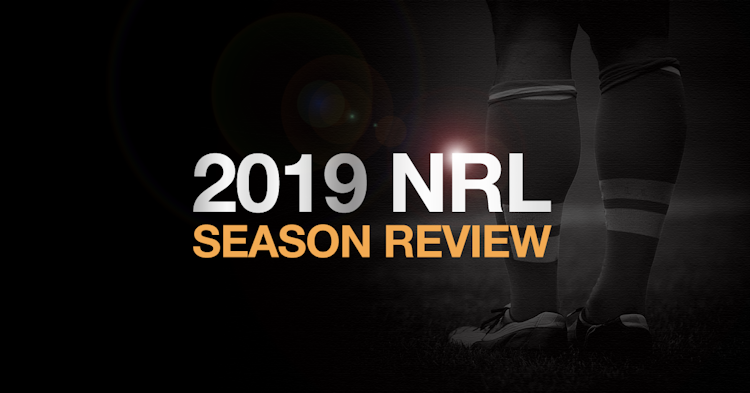NRL Stats Review: Key Statistics that defined the 2019 season
Last updated: Oct 9, 2019, 3:52AM | Published: Oct 8, 2019, 11:49PM
The bandwagon hitched to the back of the Green Machine swelled on its way into the Grand Final, but it was the preseason favourites that left ANZ Stadium with the Provan-Summons trophy.
Lost in the inherent outrage following the season finale is the fact that this Roosters team is one of the best we've ever seen. It's not just the fact they've become the first team to go back-to-back in the NRL era. They're stacked across the park, fielded the most dangerous attack in the competition, and their defence is a testament to what it takes to get through a season and finish at the top of the pile.
We're always hearing about "bringing the little man back", but it's the heavies in the middle sparking improvement and success. Dominance through the middle isn't limited to props, though. The wing position is increasing in size and gaining more importance to a side. Parramatta knows better than anybody how much an effective metre-eater can be to the overall performance across a season.
But in the end, defence wins premierships. Or in Canberra's case, gets you close. Once again, a top performer without the ball in hand handled the trophy on Grand Final night.
As we embark on one last journey through some of the key statistics in 2019, some may be surprised the referees won't get a mention beyond this reference.
Believe it or not, the players had a bit of an impact on how the season shaped up.
Another Team Runs Their Way To The Premiership
Shock: Good teams get up the field, score points, and win.
Sydney's impressive yardage game saved them in the Grand Final. When the going got tough, Sio Siua Taukeiaho and Jared Waerea-Hargreaves got to work to combine for 369 metres on an incredible 11.9 metres per carry.
For the fifth time in six seasons, the premiership-winning team finished inside the top two in the NRL in average running metres per game. In fact, the Roosters topped the list with 1,666 metres per game on 9.52 metres per run.
| Team | Runs | Running Metres | Metres Per Run |
| Roosters | 174.9 | 1,666.30 | 9.525936905 |
| Eels | 178.4 | 1,652.30 | 9.264395083 |
| Storm | 180.3 | 1,647.20 | 9.134319162 |
| Sea Eagles | 181.8 | 1,614.20 | 8.880236987 |
| Wests Tigers | 184.7 | 1,604.50 | 8.686893751 |
| Rabbitohs | 181.4 | 1,592.50 | 8.780273637 |
| Raiders | 175.7 | 1,590.90 | 9.052687039 |
| Bulldogs | 184.2 | 1,582.90 | 8.592626103 |
| Sharks | 178.6 | 1,577.80 | 8.832288401 |
| Broncos | 170.5 | 1,576.80 | 9.246774572 |
| Warriors | 175.2 | 1,568.50 | 8.954091342 |
| Panthers | 181.4 | 1,567.20 | 8.640937285 |
| Dragons | 176.4 | 1,552.60 | 8.802740373 |
| Cowboys | 177 | 1,534.20 | 8.669884624 |
| Knights | 171.1 | 1,506.20 | 8.803945446 |
| Titans | 175.6 | 1,505.40 | 8.571530249 |
Looking further down the list, six of the eight Top 8 teams featured in the top half in the competition for running metres. It's no coincidence that the two Top 8 teams in the bottom half - the Broncos and Sharks - both exited the finals after Week 1.
Rugby league is a yardage game.
The Broncos and Sharks didn't achieve what they wanted to in 2019 on the back of disappointing numbers. Meanwhile, the Knights failed to see much of an improvement despite the preseason hype, and it's largely due to finishing in the bottom three in running metres for the fifth consecutive season.
The Eels, on the other hand, can attribute much of their rise from the wooden spoon in 2018 to Week 2 of the finals in 2019 to their improved yardage numbers. The Eels ran for just 1,420 metres in 2018 to rank 11th in the NRL. Fast-forward 12 months and their 1,652 metres sits just behind the Roosters. Their rise in the ranks can be put down to the increased productivity and consistency from the wing position.
It's a position gaining in importance across the league.
<ad>
Wingers Rising In The Ranks
The importance of a strong winger willing and capable of taking tough carries to start sets is most evident in the Eels across the last two years.
By replacing Bevan French, Josh Hoffman and George Jennings with Maika Sivo and Blake Ferguson, the Eels were able to generate extra yardage to start their sets. Sivo's 146.3 metres and 156.5 metres per game proved the difference in 2019. When Ferguson was out injured, Brad Arthur chose to play Brad Takairangi on the wing for the first time in his career. He managed 148.5 metres per game across that four-game stretch to at least replicate Ferguson's yardage if not his finishing ability.
It's a trend developing across the NRL with wingers increasing their running metres and beginning to feature more in the Top 15 metre eaters in the competition.
Just three wingers ended in the Top 15 in running metres in 2016. Four featured in the following two years with 2019 finishing with five wingers inside the Top 15 in the NRL for average running metres per game.
The Top 10 wingers in running metres throughout 2017 and 2018 combined to average 154.3 metres in both seasons. In 2019, the Top 10 averaged 164.3 running metres per game.
The wing position was once a spot that went ignored. Teams certainly weren't carving out big chunks of the salary cap to spend on those filling the two and five jerseys. These days, wingers are extra props and tasked with starting sets strong through the middle and finishing them with jaw-dropping athleticism in the corner.
They're no longer a place to skimp on the salary cap and fill with serviceable players. Wingers are on the rise, and they'll be a key consideration when assessing squads ahead of the 2020 season.
Looking Left In Attack
Surprise, surprise, the Roosters played with the best left-side attack in the NRL in 2019.
Their 57 tries on the left side accounted for 49% of Sydney's total tries this season. It was only fitting that the awesome foursome on that side combined to score the match-winning try in the Grand Final.
It's a perfectly executed play that starts before Boyd Cordner even plays the ball. With Jordan Rapana slow to get back and Joey Leilua in the tackle and unable to get to marker, Luke Keary looks up. He sees a potential numerical advantage should he be able to engage Rapana who is defending two in.
Keary takes Rapana's attention just enough before feeding Latrell Mitchell who gets far enough through the line to get his arms free. That forces Aidan Sezer in and allows Daniel Tupou to streak down the sideline.
With only one man to beat, Tupou hands it off to the always present James Tedesco who completes the defining moment of the match.
The Roosters left side attack has been lethal all season.
Tupou's career year ended with 15 tries, six try assists, 12 line breaks and 171 running metres per game. On his inside, Mitchell's 273 points led the NRL in points scored while the 22-year old achieved career-highs with 19 tries and 10 try assists. Providing the destructive pair on his outside, Keary's 22 try assists rank second in the NRL.
No matter how much an opposing defence schemed against this Roosters left edge, nobody could stop them. Nobody will be surprised to see the trio improve further in 2020 either.
Looking Right In Attack
It may come as a surprise considering how inconsistent and disjointed they were all season, but the Sharks owned the best right-side attack in 2019.
The Sharks scored 41 tries down that side of the field across 25 games.
Shaun Johnson took the best right-side attack from across the ditch to the Shire despite only playing 18 games this season. Throughout his abridged first year at the Sharks, Johnson finished with 16 try assists and 14 line-break assists. His combination with rookie backrower, Briton Nikora, caused opposing defences all sorts of trouble with the 21-year-old scoring seven tries while breaking the line 11 times in his debut season.
Nikora runs fearless and veteran lines. He consistently timed his run, and when the gap opened up, Johnson sent him through it.
The Sharks disappointed in 2019. Issues off the field and clashes in opinion and personality clearly had an impact on their overall performance. However, with the Johnson/Nikora combination already one of the most dangerous in the NRL, there is hope for an improved 2020 campaign.
The Not So Secret Recipe For Success
As has been the case for now 13 of the last 14 seasons, one of the top two defensive teams in the NRL lifted the trophy.
It's an incredible number and one the Raiders identified at the back end of 2018. Having wrapped up the season with the best performing attack in the NRL scoring 22.5 points per game, crossing the line wasn't an issue for the Raiders. Stopping teams coming back the other way was, though.
The Raiders allowed 22.5 points to be poured through them a game in 2018. It doesn't matter how good you are in attack if you're allowing the opposing team to score just as many. And given Canberra's reputation as faders and genuine choke artists, they only managed 10 wins to finish outside the Top 8.
Skip forward to the aftermath of the Grand Final, and we're talking about the Raiders as one of the best defensive teams in the competition. Andrew McFadden and Ricky Stuart worked wonders in the preseason for the Raiders to navigate 2019 conceding just 15.1 points per game.
They shaved a little bit off in attack to improve their defence, and the results speak for themselves.
So too do the results of the Roosters.
They sailed through the regular season with the second-best defence in the competition, but when it really matters, this side is a brick wall.
Two years in a row they've been the best defensive team in the finals. Most of the talk is centred around the talent they have in attack. However, it's how they combine in defence that has seen the Roosters become the first back-to-back premiers in the NRL era.
Did you enjoy this article? Leave a comment below, or join the conversation on the Stats Insider Twitter or Facebook page.



